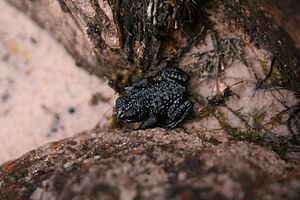Pebble toad facts for kids
Quick facts for kids Pebble toad |
|
|---|---|
 |
|
| Conservation status | |
| Scientific classification |
The pebble toad, also known as Oreophrynella nigra, is a special kind of toad. It belongs to the Bufonidae family, which includes many different toads. This unique toad lives only in a specific part of Venezuela, in a mountainous area called the Guiana Highlands. It has been found on two flat-topped mountains, or tepuis, named Kukenan-tepui and Yuruani-tepui.
Contents
What the Pebble Toad Looks Like and How It Behaves
The pebble toad is quite small. Male toads are usually about 1.65 to 2.35 centimeters long. Female toads are a bit bigger, from 2.04 to 3 centimeters long.
This toad has a very clever way to escape from danger. When it feels threatened, it pulls its legs and head close to its body. Then, it tenses up and forms a tight ball shape. If the toad is on a slope, this ball shape allows it to roll quickly down the hill. This makes it look just like a loose pebble rolling away. This trick helps it get away from predators, which are animals that hunt it. Its dark black and gray colors also help it blend in with the rocks and sand where it lives. Some people might even see its color as a dark navy blue.
Where the Pebble Toad Lives and How It Is Protected
The pebble toad's natural habitats are rocky areas and wet, spongy lands called peat bogs. These are found high up in the mountains, specifically on the flat-topped tepui environments. They live at elevations between 2,300 and 2,700 meters above sea level.
Scientists have classified the pebble toad as a vulnerable species. This means it is at risk of becoming endangered. It is considered vulnerable because it lives in a very small and specific area. Protecting its unique mountain home is important for its survival.
The Pebble Toad in Media
This interesting toad was once shown on a BBC television series called Life. In the show, a tarantula spider was seen chasing the pebble toad, highlighting its amazing escape strategy.
See also
 In Spanish: Oreophrynella nigra para niños
In Spanish: Oreophrynella nigra para niños


